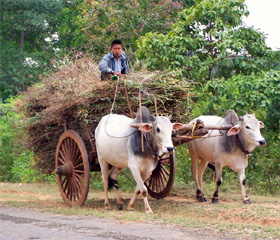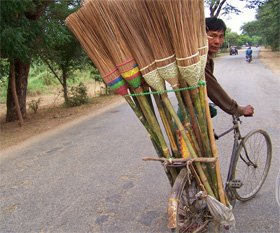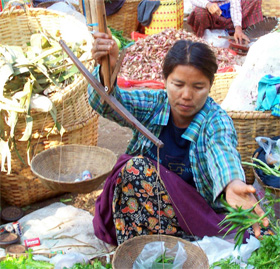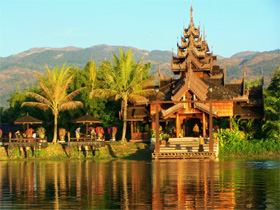|
We appreciate it when our guests share their stories with us and allow us to post them on our blog for everyone to enjoy. Earlier this month, Nancy King and Richard Keltner, from San Francisco, traveled with us on our 11-day Myanmar (Burma) Explorer Trip. Here are Nancy’s reflections on the trip and a few of her beautiful photos: |
|||||
|
Dear Lee, We loved it! It was an incredibly well organized trip from our arrival in Yangon to when we left 11 days later. We had four guides and they could not have been more accommodating. They were educated, spoke excellent English and we had such good connection I found myself crying one time at parting (and we had no guide more than 2 -1/2 days). It is strange now in thinking I asked you about tipping because we wanted to give each a huge tip and did! And drivers couldn’t have been better as well, pulling over when I wanted a photo. The resort you put us in on Inle Lake was fabulous. I even had our boat man take us to the Princess Hotel, which is where my sister had stayed. I wanted to check out the gift shop. To my delight, our motor boat was stopped on the entry to the Hotel and a [leg rower] jumped in our boat to quietly do his one-leg rowing the entire inlet to the hotel. I did not like the Princess Hotel nearly as well as Inle Resort [where we stayed]. Yangon was very hot and humid in January but all the other cities were quite comfortable. Plus the car was always air conditioned as were the places we stayed. We were upgraded to a suite at the Trader’s Hotel and that was especially nice with the full window view of the city. The food was outstanding! Our guide ate with us and we let him order [for us] every time. Each guide handled it so smoothly. We loved having the guide and driver all to ourselves. I like the opportunity to really build a relationship among us. The excellent guides are important, as we spoke with others who had guides through someone else. They were such a strong part of our trip with our connections with them. I’m deeply into our trip and reliving it as I process my photos and edit them and get them ready to put in my 71st photo album of our life. Sincerely,
|
|
||||
Join Us for Easter in Copper Canyon
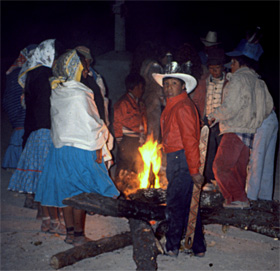 Now is the time to book your trip for Easter in Mexico’s Copper Canyon. The Easter, or Semana Santa, celebrations of the Tarahumara Indians make this time the high season of the year. Small towns which are sleepy most of the year are now alive with celebrations, 24-hours a day. The Tarahumara, who call themselves the Raramuri, celebrate for a week, with dancing, parades, bon fires, ceremonies in the churches and much drinking of tesguino, the Indians traditional corn liquor.
Now is the time to book your trip for Easter in Mexico’s Copper Canyon. The Easter, or Semana Santa, celebrations of the Tarahumara Indians make this time the high season of the year. Small towns which are sleepy most of the year are now alive with celebrations, 24-hours a day. The Tarahumara, who call themselves the Raramuri, celebrate for a week, with dancing, parades, bon fires, ceremonies in the churches and much drinking of tesguino, the Indians traditional corn liquor.
To begin to understand the Tarahumara ceremonies, one has to have a basic understanding of the Indians’ religion. Read our story about this unusual version of Catholicism practiced by these colorful cave-dwelling people.
Images of the World: Color it Yellow
Colors set our mood and add an important dimension to our feelings and memories of the places we visit. I thought it might be fun to group some of the photos from our library of California Native images by their predominant colors. This first collection is based on the color yellow.
“How wonderful yellow is. It stands for the sun.“—Vincent Van Gogh
|
The delightful city of Izamal, located on Mexico’s Yucatan Peninsula, is a magical town whose buildings are all painted yellow. |
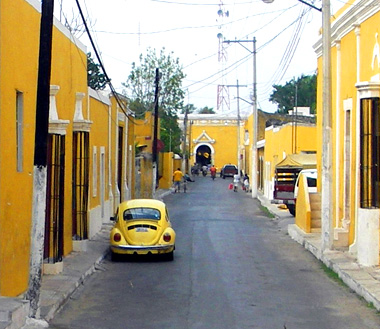 |
|
Built around the 6th century, the Shwedagon Pagoda is the most sacred Buddhist pagoda in Myanmar (Burma). It’s gilded stupa looks down on the city of Yangon (Rangoon). |
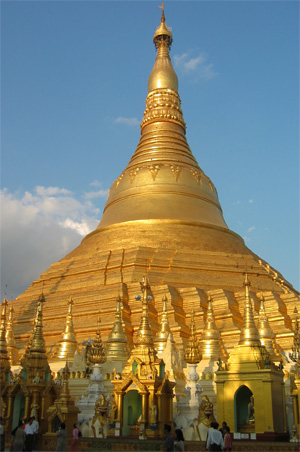 |
|
A young Tarahumara girl carries her little sister in a yellow shawl, in Mexico’s Copper Canyon. |
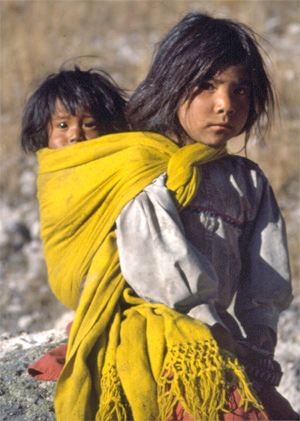 |
|
A smiling yellow buddha looks down at worshipers in one of the thousands of temples in Thailand. |
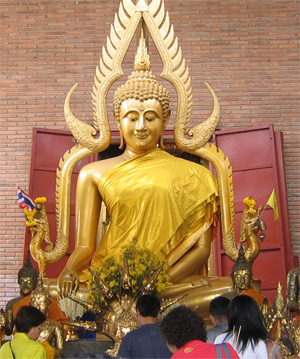 |
 |
|
Shining yellow light into the night sky, Buda Castle, in Budapest, Hungary, overlooks the Danube River. |
Happy New Year 2011!!
 As we come to the end of another year, it’s time to reflect on what we have accomplished in the last year and what we are looking forward to in the new year.
As we come to the end of another year, it’s time to reflect on what we have accomplished in the last year and what we are looking forward to in the new year.
Last year was quite an eventful year for The California Native. We made another exploration trip to Patagonia, sailing around Cape Horn on a wonderful expedition cruise, hiking on glaciers with crampons, and whitewater rafting through Argentina’s beautiful countryside. We also made several trips to Mexico, one at the invitation of President Calderon to attend a luncheon with him and celebrate the initialization of a campaign to promote the wonders of Mexico’s colonial cities.
For the upcoming year we will be offering new trips in Patagonia and China, as well as additional departure dates for our Copper Canyon trips. And of course we’ll continue to offer our exciting tours of Costa Rica, Peru, Galapagos, Bhutan, Myanmar and Ireland, and our other off-the-beaten-track destinations.
Images of the World: The Street Musicians
The world is a fascinating collage of cultures, each with its own traditions, customs and history, which gives them a uniqueness and sets them apart from all of the others. But the more we travel the more we find that so many things are the same and we are more united by our similarities than divided by our differences. In our series, Images of the World, we group our similarities to enjoy them and appreciate their cultural differences.
The Street Musicians: No matter where you are in the world, everyone enjoys music, and entertainment provided by street musicians is universal.
|
In Iquitos, Peru, a musician plays huayno music, the traditional music of the Andes, on his mandolin. |
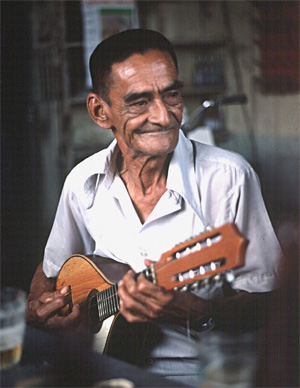 |
|
A Tarahumara musician, in Mexico’s Copper Canyon, plays guitar for visitors. |
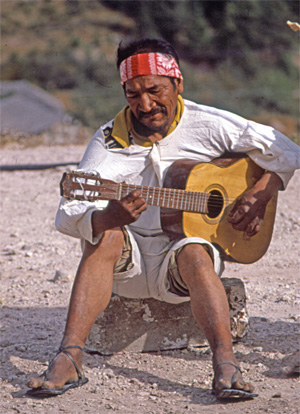 |
|
In Sydney, Australia, a colorful street-musician entertains passers-by. |
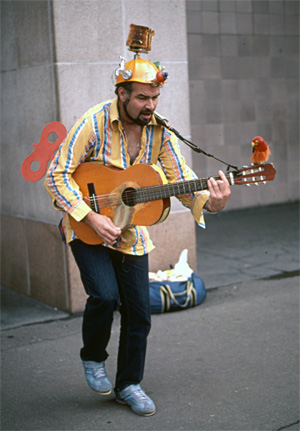 |
|
A street violinist plays on a Budapest bridge on the Danube River. |
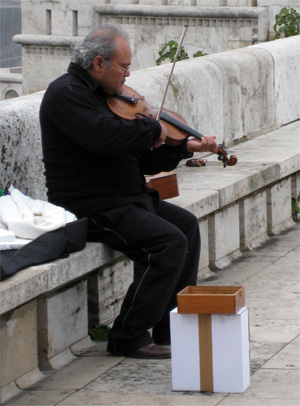 |
|
In Argentina, the tango is extremely popular, and in Buenos Aires, Argentina’s capital, street music takes the form of tango dancing. |
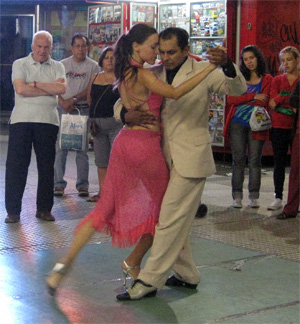 |
|
In Chiang Mai, Thailand, a street musician entertains at the annual flower festival. |
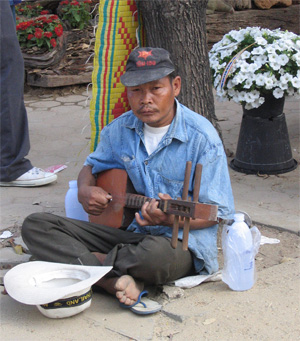 |
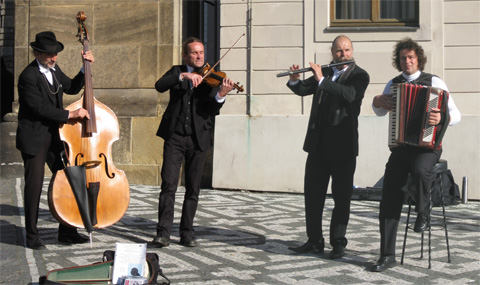 |
|
A Street quartet plays classical music outside of the Prague Castle in the Czech Republic. |
Reports from Mexico’s Copper Canyon
We receive many queries about current conditions in Mexico’s Copper Canyon, so here are some of the latest reports from recent guests on our Copper Canyon tours:
David Martin, from San Diego, CA, enjoyed our October 9, 11-day Ultimate Tour. “The whole trip exceeded [my expectations]! Food, lodging, views, train trip, Jessica. Could not have asked for a better guide on this trip. Personable, sense of humor, and a love for Mexico that pours forth in her discussions…it was wonderful! She really made the trip. Super knowledgeable.” His travel companion, Ann Cunningham, concurred, “I have collected articles since 1986 on Copper Canyon—my dream was realized to the nth degree.”
On the same trip, Irene and Randy Pollard, from Farmville, NC, reported that, “Jessica was one of the best guides we have ever experienced (We have traveled a lot). Her maturity and efforts to insure each person’s comfort and satisfaction was remarkable. We thoroughly enjoyed every part of this trip. Jessica provided opportunities at all ability levels. I wasn’t expecting the excellent accommodations—when materials mentioned ‘local’, I had expected much less.”
As a single traveler on our 8-day Independent Trip, Bruce M. Hale, from La Crescenta, CA, returned on November 17 and reported: “I liked all the hotels and staff. They all provided excellent lodging and personalized service even though I was solo. I particularly like Paraiso del Oso—the rustic atmosphere, the remote location [and] the chance to go to Urique. You made it easy to travel alone and your providers all performed as expected. Also, I’m pleased to have confirmed the safety aspect. I never felt in any danger, everything was fine.”
We, at California Native, value our guests comments, opinions and suggestions. These together with reports from our guides and inspection trips by our staff help us to keep our trips safe, fun and educational.
A Tisket A Tasket a Copper Canyon Basket
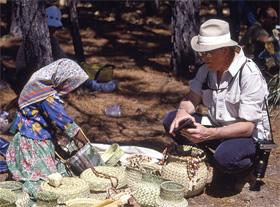
Visitors to the Copper Canyon area are always pleasantly surprised by the wide variety of craftsware and folk art available for purchase. The remote life and character of the Tarahumara Indians has fostered a tradition of crafts making as a part of their life-style.
While traveling through the region you will find very inexpensively priced baskets, belts, dolls, pottery and musical instruments.
The baskets are made out of the leaves of the agave as well as pine needles and range in size from tiny to large. Visitors purchasing baskets find that they can pack them one inside the other to conserve space during their trip. Once at home, the baskets of pine needles hold their scent of pine forests and become a wonderful reminder of the trip, and they are utilitarian as well as beautiful. The Tarahumara pottery is quite sturdy and is designed to be more functional then decorative.
Music is an important part of the Indians daily living and also plays an important roll in their ceremonies and festivals. Their musical instruments include violins, drums and wooden flutes. They learned the art of violin making from the Spaniards in the 18th century.
Carved wooden dolls dressed in typical Tarahumara fashion are for sale in a variety of sizes and portray the various activities of Tarahumara life—mothers wearing shawls while carrying babies on their backs, ladies weaving on hand-looms, and men carrying tools or musical instruments and wearing their traditional headgear.
Crafts can be purchased from the Indians who set up their merchandise on rocks along the trails and in all sorts of unlikely nooks and crannies. Crafts are also available in stores, and one that we recommend is the Mission Store in Creel, located right on the town square. Profits go to the hospital which serves the Tarahumara Indians.
Guarding the Sacred Valley of the Incas
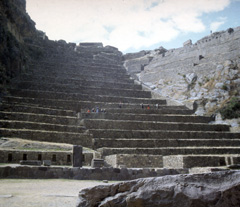
Standing guard over the Urubamba Valley, the Sacred Valley of the Incas, Ollantaytambo’s great terraces and massive stoneworks served as a ceremonial center and fortress, protecting the heart of the Incan empire from its enemies. Its massive structures were crafted by moving giant stones for miles using sheer manpower and ingenious engineering devices. The builders even re-channeled a river to allow the giant stones to be maneuvered across. It was here at Ollantaytambo that the Incas staged their last victory over the Spanish.
In 1536, the Inca ruler Manco Inca led a rebellion against the Spanish invaders. To quell the rebellion, Francisco Pizarro dispatched his younger brother, Hernando, to Ollantaytambo to capture Manco. With a force of 70 cavalry, 30 foot soldiers, and a “large contingent of native auxiliaries,” the confident Spaniards planned a dawn attack to surprise the sleeping Indians, but it didn’t work. The Spaniards were overwhelmed by showers of arrows, spears and boulders, which rained down from the high terraces above the city. Then, by diverting the Patachanca River through previously dug channels, the Incas flooded the plains below the fortress, and the bewildered Spaniards found themselves mired in mud and water up to their horses’ bellies. They had no choice but to retreat.
Pizarro returned, this time with four times the force. The city fell but Manco escaped. Two years later Pizarro captured Manco’s sister and, when Manco refused to negotiate, had her stripped naked, flogged, and shot to death with arrows. He then had her body tied to a raft and floated down the Urubamba River. Pizarro was not a guy to mess with!
What in the World is a Tico?
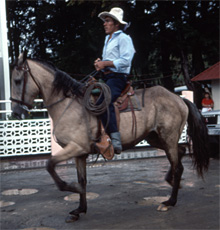 What in the world is a Tico? Sounds exotic. Maybe it’s something like a Piña Colada or a Cappuccino. Or maybe it’s one of those little biting pests that you find in tropical places. Wrong! A Tico is a very special group of people that inhabit one of the most beautiful, tropical and hidden paradises in the world—Costa Rica. “Tico” is simply the name commonly used to refer to the native inhabitants of Costa Rica.
What in the world is a Tico? Sounds exotic. Maybe it’s something like a Piña Colada or a Cappuccino. Or maybe it’s one of those little biting pests that you find in tropical places. Wrong! A Tico is a very special group of people that inhabit one of the most beautiful, tropical and hidden paradises in the world—Costa Rica. “Tico” is simply the name commonly used to refer to the native inhabitants of Costa Rica.
But why “Tico“? In the Spanish world, the diminutive, formed by dropping the final “o” or “a” and adding an “ito” or “ita” depending on the gender, is commonly used out of friendliness and familiarity. It’s much more cariñoso (affectionate) to call your amigo (friend) an amigito (little friend).
About a century ago many Costa Ricans made the mistake of forming the diminutive by adding an “ico” to the end of words. So poquito (the Spanish diminutive of the word poco, little, few) would be poquiTICO when spoken by a Costa Rican. Because of their friendly and warm-hearted manner, the people of Costa Rica commonly used the diminutive in their everyday speech patterns and thus earned the nickname “Ticos” from outsiders.
Although the Costa Rican educational system has now taught most of the Ticos the correct grammatical usage of the diminutive forms in Spanish, the term “Tico” remains to commemorate this charming affection of the past.

